Technological Innovations and Strategic Management in Retail
VerifiedAdded on 2020/04/21
|19
|3603
|89
Essay
AI Summary
This essay discusses the strategic importance of technological innovations in maintaining competitive advantage for retail companies, using Cotton On Group as a case study. It highlights how the retailer's adoption of advanced data management systems like DSM contributed to its market leadership by enhancing efficiency and decision-making processes. The analysis underscores the necessity for substantial investment in human resources and technology to support innovation. Furthermore, it emphasizes the role of stakeholder approval in making these innovations profitable. Overall, the essay concludes that entering new markets and adopting cutting-edge technologies are essential strategies for retail companies aiming to sustain their market positions.

Running head: INTERNAL INNOVATION
Disruptive innovation
Name of the Student:
Name of the University:
Author Note:
Disruptive innovation
Name of the Student:
Name of the University:
Author Note:
Paraphrase This Document
Need a fresh take? Get an instant paraphrase of this document with our AI Paraphraser
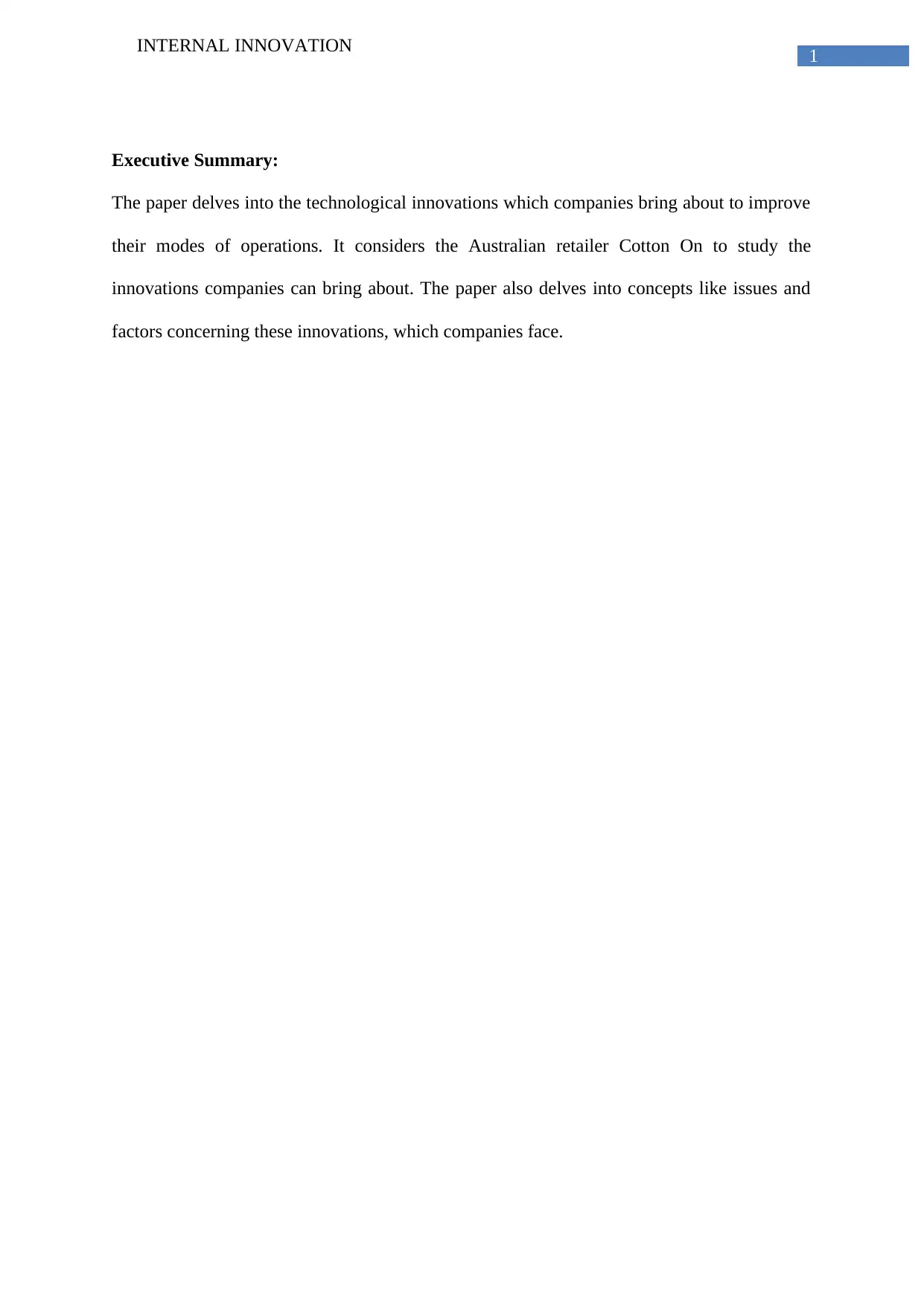
1
INTERNAL INNOVATION
Executive Summary:
The paper delves into the technological innovations which companies bring about to improve
their modes of operations. It considers the Australian retailer Cotton On to study the
innovations companies can bring about. The paper also delves into concepts like issues and
factors concerning these innovations, which companies face.
INTERNAL INNOVATION
Executive Summary:
The paper delves into the technological innovations which companies bring about to improve
their modes of operations. It considers the Australian retailer Cotton On to study the
innovations companies can bring about. The paper also delves into concepts like issues and
factors concerning these innovations, which companies face.
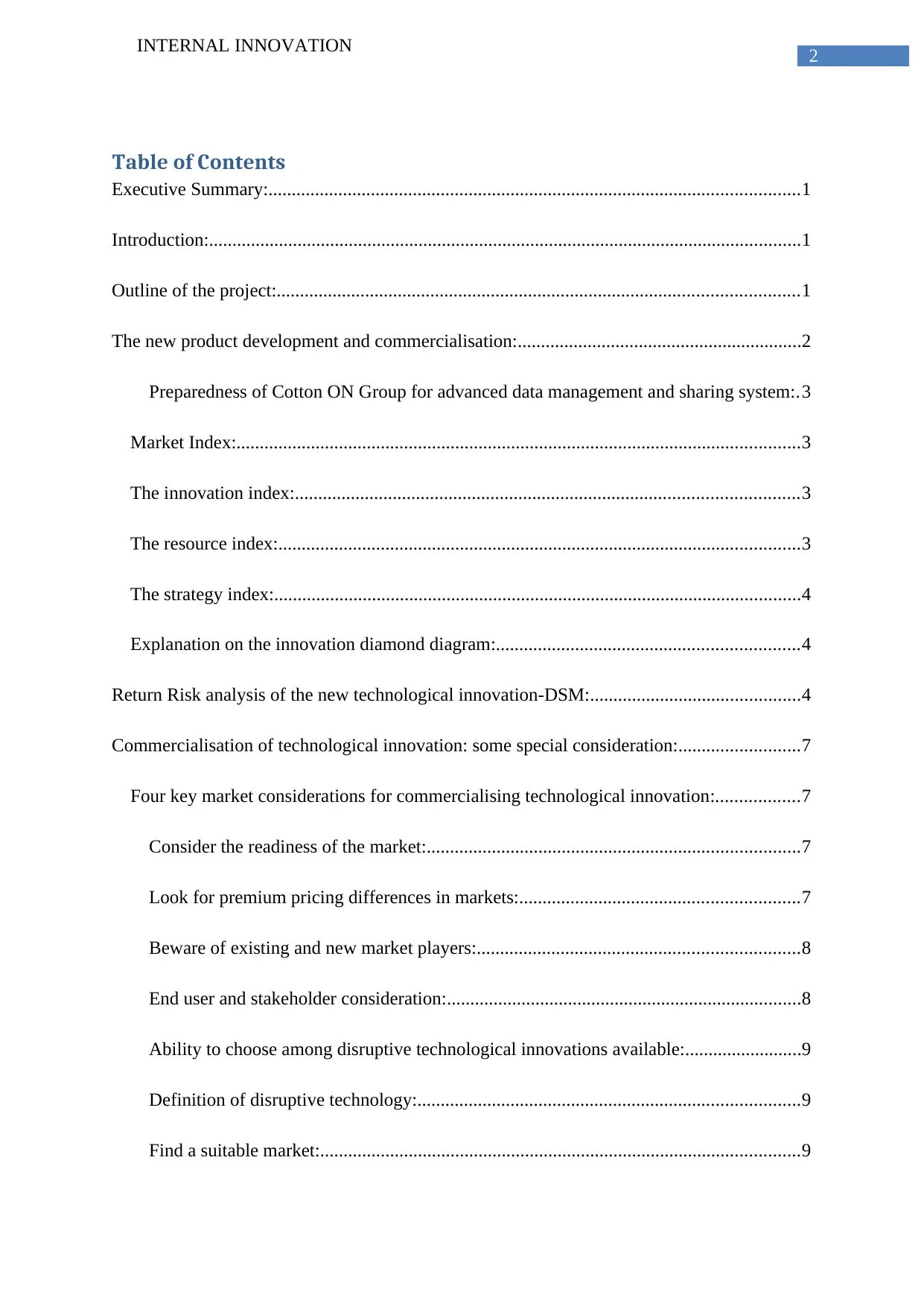
2
INTERNAL INNOVATION
Table of Contents
Executive Summary:..................................................................................................................1
Introduction:...............................................................................................................................1
Outline of the project:................................................................................................................1
The new product development and commercialisation:.............................................................2
Preparedness of Cotton ON Group for advanced data management and sharing system:.3
Market Index:.........................................................................................................................3
The innovation index:............................................................................................................3
The resource index:................................................................................................................3
The strategy index:.................................................................................................................4
Explanation on the innovation diamond diagram:.................................................................4
Return Risk analysis of the new technological innovation-DSM:.............................................4
Commercialisation of technological innovation: some special consideration:..........................7
Four key market considerations for commercialising technological innovation:..................7
Consider the readiness of the market:................................................................................7
Look for premium pricing differences in markets:............................................................7
Beware of existing and new market players:.....................................................................8
End user and stakeholder consideration:............................................................................8
Ability to choose among disruptive technological innovations available:.........................9
Definition of disruptive technology:..................................................................................9
Find a suitable market:.......................................................................................................9
INTERNAL INNOVATION
Table of Contents
Executive Summary:..................................................................................................................1
Introduction:...............................................................................................................................1
Outline of the project:................................................................................................................1
The new product development and commercialisation:.............................................................2
Preparedness of Cotton ON Group for advanced data management and sharing system:.3
Market Index:.........................................................................................................................3
The innovation index:............................................................................................................3
The resource index:................................................................................................................3
The strategy index:.................................................................................................................4
Explanation on the innovation diamond diagram:.................................................................4
Return Risk analysis of the new technological innovation-DSM:.............................................4
Commercialisation of technological innovation: some special consideration:..........................7
Four key market considerations for commercialising technological innovation:..................7
Consider the readiness of the market:................................................................................7
Look for premium pricing differences in markets:............................................................7
Beware of existing and new market players:.....................................................................8
End user and stakeholder consideration:............................................................................8
Ability to choose among disruptive technological innovations available:.........................9
Definition of disruptive technology:..................................................................................9
Find a suitable market:.......................................................................................................9
⊘ This is a preview!⊘
Do you want full access?
Subscribe today to unlock all pages.

Trusted by 1+ million students worldwide
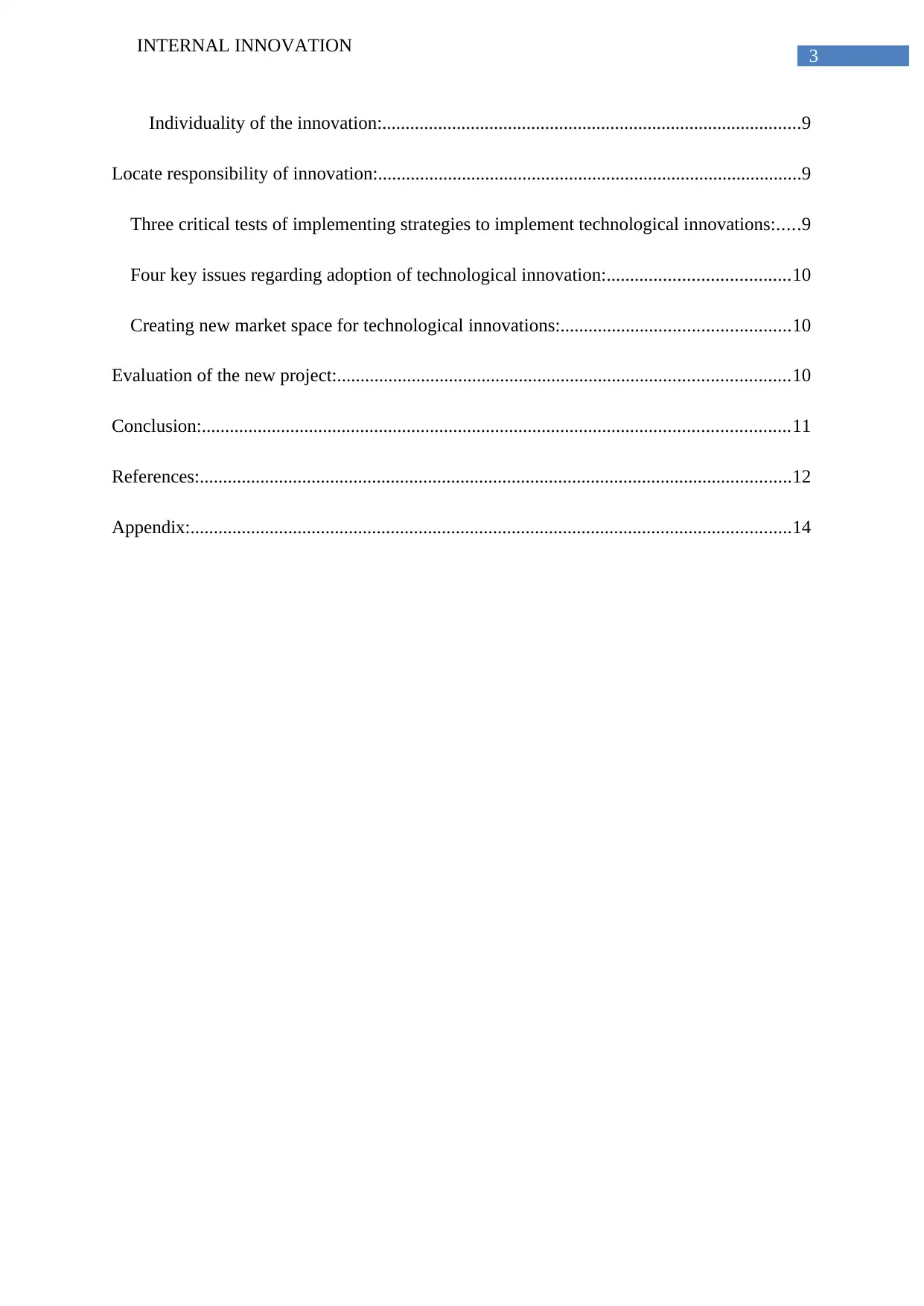
3
INTERNAL INNOVATION
Individuality of the innovation:..........................................................................................9
Locate responsibility of innovation:...........................................................................................9
Three critical tests of implementing strategies to implement technological innovations:.....9
Four key issues regarding adoption of technological innovation:.......................................10
Creating new market space for technological innovations:.................................................10
Evaluation of the new project:.................................................................................................10
Conclusion:..............................................................................................................................11
References:...............................................................................................................................12
Appendix:.................................................................................................................................14
INTERNAL INNOVATION
Individuality of the innovation:..........................................................................................9
Locate responsibility of innovation:...........................................................................................9
Three critical tests of implementing strategies to implement technological innovations:.....9
Four key issues regarding adoption of technological innovation:.......................................10
Creating new market space for technological innovations:.................................................10
Evaluation of the new project:.................................................................................................10
Conclusion:..............................................................................................................................11
References:...............................................................................................................................12
Appendix:.................................................................................................................................14
Paraphrase This Document
Need a fresh take? Get an instant paraphrase of this document with our AI Paraphraser
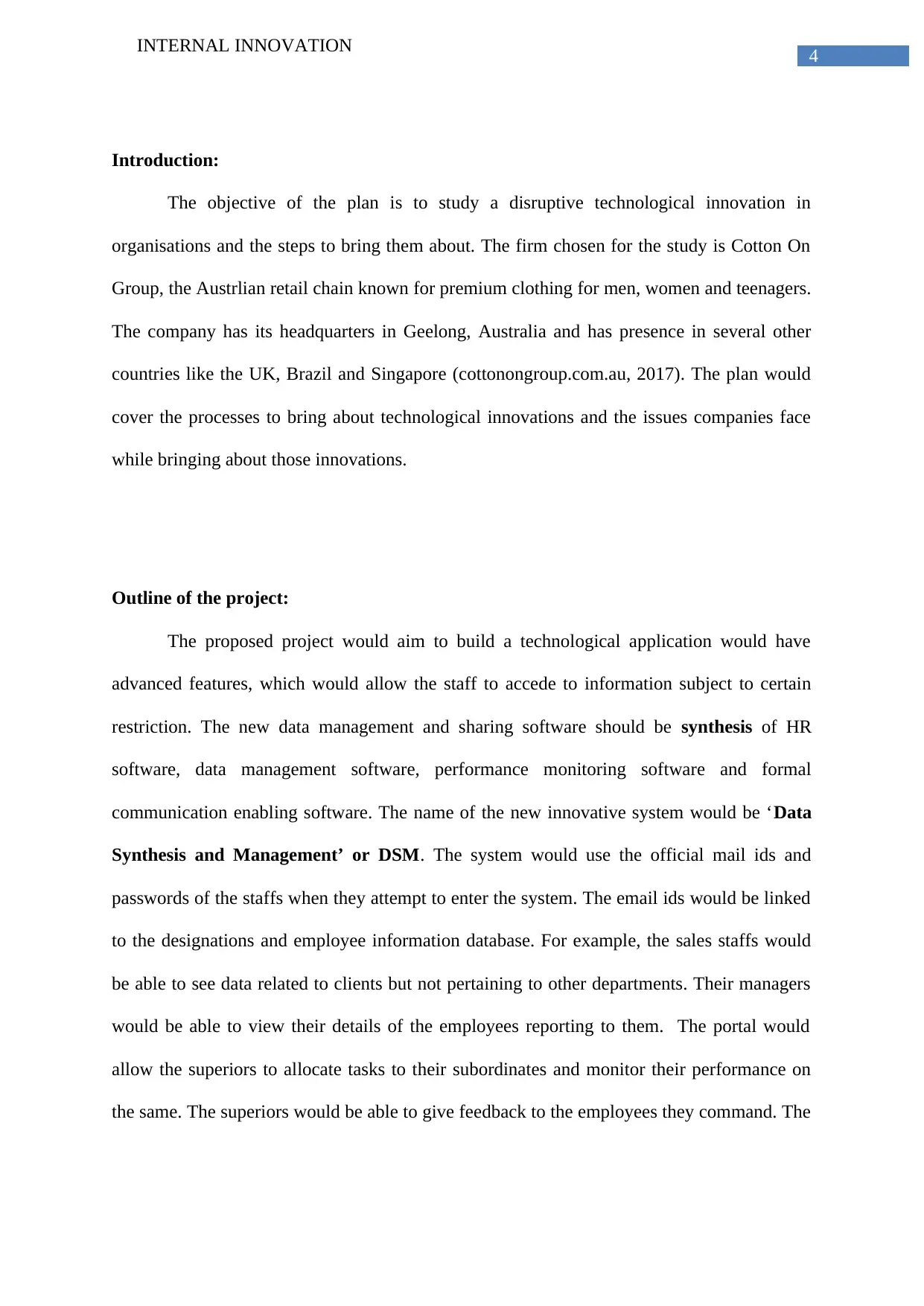
4
INTERNAL INNOVATION
Introduction:
The objective of the plan is to study a disruptive technological innovation in
organisations and the steps to bring them about. The firm chosen for the study is Cotton On
Group, the Austrlian retail chain known for premium clothing for men, women and teenagers.
The company has its headquarters in Geelong, Australia and has presence in several other
countries like the UK, Brazil and Singapore (cottonongroup.com.au, 2017). The plan would
cover the processes to bring about technological innovations and the issues companies face
while bringing about those innovations.
Outline of the project:
The proposed project would aim to build a technological application would have
advanced features, which would allow the staff to accede to information subject to certain
restriction. The new data management and sharing software should be synthesis of HR
software, data management software, performance monitoring software and formal
communication enabling software. The name of the new innovative system would be ‘Data
Synthesis and Management’ or DSM. The system would use the official mail ids and
passwords of the staffs when they attempt to enter the system. The email ids would be linked
to the designations and employee information database. For example, the sales staffs would
be able to see data related to clients but not pertaining to other departments. Their managers
would be able to view their details of the employees reporting to them. The portal would
allow the superiors to allocate tasks to their subordinates and monitor their performance on
the same. The superiors would be able to give feedback to the employees they command. The
INTERNAL INNOVATION
Introduction:
The objective of the plan is to study a disruptive technological innovation in
organisations and the steps to bring them about. The firm chosen for the study is Cotton On
Group, the Austrlian retail chain known for premium clothing for men, women and teenagers.
The company has its headquarters in Geelong, Australia and has presence in several other
countries like the UK, Brazil and Singapore (cottonongroup.com.au, 2017). The plan would
cover the processes to bring about technological innovations and the issues companies face
while bringing about those innovations.
Outline of the project:
The proposed project would aim to build a technological application would have
advanced features, which would allow the staff to accede to information subject to certain
restriction. The new data management and sharing software should be synthesis of HR
software, data management software, performance monitoring software and formal
communication enabling software. The name of the new innovative system would be ‘Data
Synthesis and Management’ or DSM. The system would use the official mail ids and
passwords of the staffs when they attempt to enter the system. The email ids would be linked
to the designations and employee information database. For example, the sales staffs would
be able to see data related to clients but not pertaining to other departments. Their managers
would be able to view their details of the employees reporting to them. The portal would
allow the superiors to allocate tasks to their subordinates and monitor their performance on
the same. The superiors would be able to give feedback to the employees they command. The
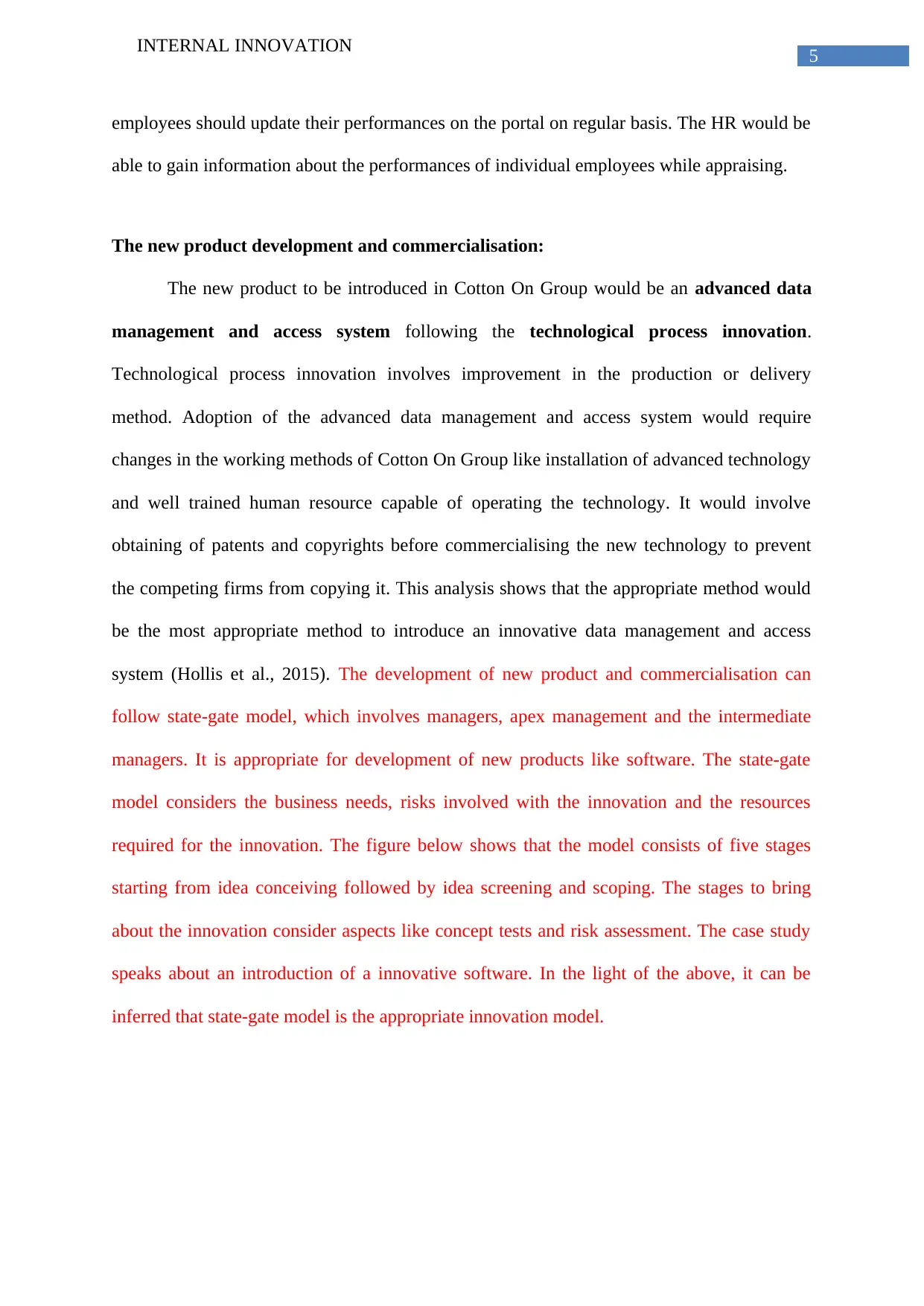
5
INTERNAL INNOVATION
employees should update their performances on the portal on regular basis. The HR would be
able to gain information about the performances of individual employees while appraising.
The new product development and commercialisation:
The new product to be introduced in Cotton On Group would be an advanced data
management and access system following the technological process innovation.
Technological process innovation involves improvement in the production or delivery
method. Adoption of the advanced data management and access system would require
changes in the working methods of Cotton On Group like installation of advanced technology
and well trained human resource capable of operating the technology. It would involve
obtaining of patents and copyrights before commercialising the new technology to prevent
the competing firms from copying it. This analysis shows that the appropriate method would
be the most appropriate method to introduce an innovative data management and access
system (Hollis et al., 2015). The development of new product and commercialisation can
follow state-gate model, which involves managers, apex management and the intermediate
managers. It is appropriate for development of new products like software. The state-gate
model considers the business needs, risks involved with the innovation and the resources
required for the innovation. The figure below shows that the model consists of five stages
starting from idea conceiving followed by idea screening and scoping. The stages to bring
about the innovation consider aspects like concept tests and risk assessment. The case study
speaks about an introduction of a innovative software. In the light of the above, it can be
inferred that state-gate model is the appropriate innovation model.
INTERNAL INNOVATION
employees should update their performances on the portal on regular basis. The HR would be
able to gain information about the performances of individual employees while appraising.
The new product development and commercialisation:
The new product to be introduced in Cotton On Group would be an advanced data
management and access system following the technological process innovation.
Technological process innovation involves improvement in the production or delivery
method. Adoption of the advanced data management and access system would require
changes in the working methods of Cotton On Group like installation of advanced technology
and well trained human resource capable of operating the technology. It would involve
obtaining of patents and copyrights before commercialising the new technology to prevent
the competing firms from copying it. This analysis shows that the appropriate method would
be the most appropriate method to introduce an innovative data management and access
system (Hollis et al., 2015). The development of new product and commercialisation can
follow state-gate model, which involves managers, apex management and the intermediate
managers. It is appropriate for development of new products like software. The state-gate
model considers the business needs, risks involved with the innovation and the resources
required for the innovation. The figure below shows that the model consists of five stages
starting from idea conceiving followed by idea screening and scoping. The stages to bring
about the innovation consider aspects like concept tests and risk assessment. The case study
speaks about an introduction of a innovative software. In the light of the above, it can be
inferred that state-gate model is the appropriate innovation model.
⊘ This is a preview!⊘
Do you want full access?
Subscribe today to unlock all pages.

Trusted by 1+ million students worldwide
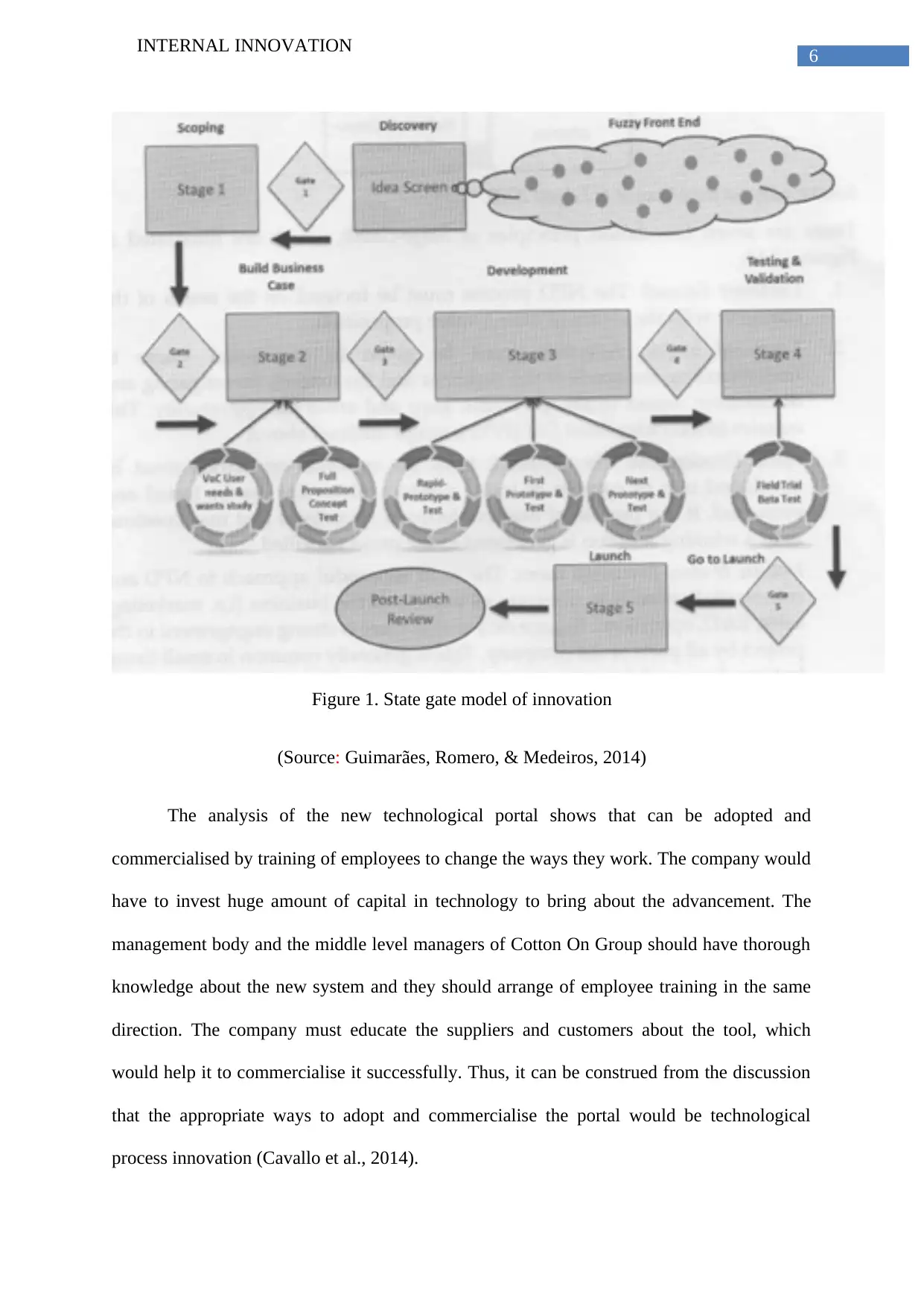
6
INTERNAL INNOVATION
Figure 1. State gate model of innovation
(Source: Guimarães, Romero, & Medeiros, 2014)
The analysis of the new technological portal shows that can be adopted and
commercialised by training of employees to change the ways they work. The company would
have to invest huge amount of capital in technology to bring about the advancement. The
management body and the middle level managers of Cotton On Group should have thorough
knowledge about the new system and they should arrange of employee training in the same
direction. The company must educate the suppliers and customers about the tool, which
would help it to commercialise it successfully. Thus, it can be construed from the discussion
that the appropriate ways to adopt and commercialise the portal would be technological
process innovation (Cavallo et al., 2014).
INTERNAL INNOVATION
Figure 1. State gate model of innovation
(Source: Guimarães, Romero, & Medeiros, 2014)
The analysis of the new technological portal shows that can be adopted and
commercialised by training of employees to change the ways they work. The company would
have to invest huge amount of capital in technology to bring about the advancement. The
management body and the middle level managers of Cotton On Group should have thorough
knowledge about the new system and they should arrange of employee training in the same
direction. The company must educate the suppliers and customers about the tool, which
would help it to commercialise it successfully. Thus, it can be construed from the discussion
that the appropriate ways to adopt and commercialise the portal would be technological
process innovation (Cavallo et al., 2014).
Paraphrase This Document
Need a fresh take? Get an instant paraphrase of this document with our AI Paraphraser
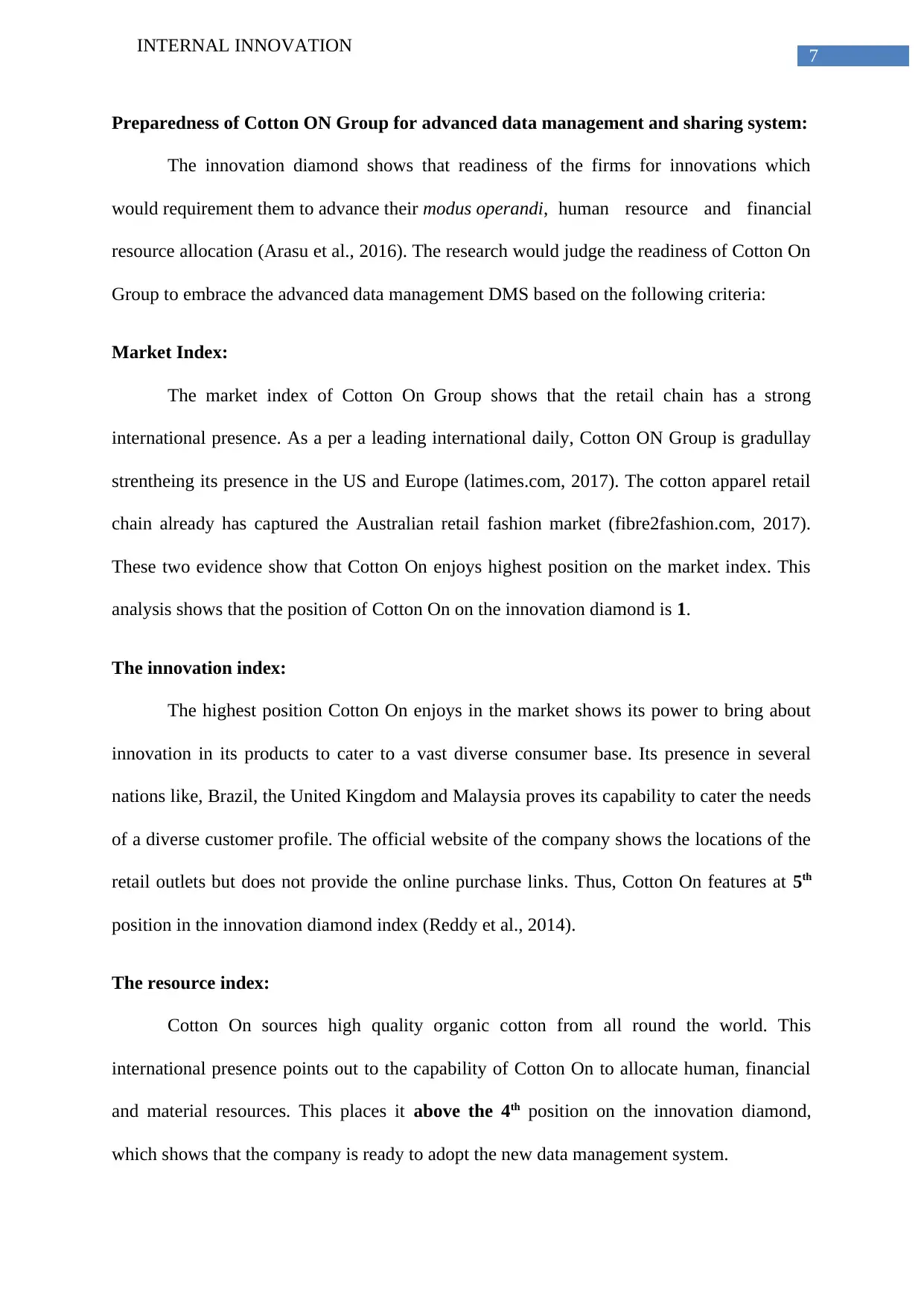
7
INTERNAL INNOVATION
Preparedness of Cotton ON Group for advanced data management and sharing system:
The innovation diamond shows that readiness of the firms for innovations which
would requirement them to advance their modus operandi, human resource and financial
resource allocation (Arasu et al., 2016). The research would judge the readiness of Cotton On
Group to embrace the advanced data management DMS based on the following criteria:
Market Index:
The market index of Cotton On Group shows that the retail chain has a strong
international presence. As a per a leading international daily, Cotton ON Group is gradullay
strentheing its presence in the US and Europe (latimes.com, 2017). The cotton apparel retail
chain already has captured the Australian retail fashion market (fibre2fashion.com, 2017).
These two evidence show that Cotton On enjoys highest position on the market index. This
analysis shows that the position of Cotton On on the innovation diamond is 1.
The innovation index:
The highest position Cotton On enjoys in the market shows its power to bring about
innovation in its products to cater to a vast diverse consumer base. Its presence in several
nations like, Brazil, the United Kingdom and Malaysia proves its capability to cater the needs
of a diverse customer profile. The official website of the company shows the locations of the
retail outlets but does not provide the online purchase links. Thus, Cotton On features at 5th
position in the innovation diamond index (Reddy et al., 2014).
The resource index:
Cotton On sources high quality organic cotton from all round the world. This
international presence points out to the capability of Cotton On to allocate human, financial
and material resources. This places it above the 4th position on the innovation diamond,
which shows that the company is ready to adopt the new data management system.
INTERNAL INNOVATION
Preparedness of Cotton ON Group for advanced data management and sharing system:
The innovation diamond shows that readiness of the firms for innovations which
would requirement them to advance their modus operandi, human resource and financial
resource allocation (Arasu et al., 2016). The research would judge the readiness of Cotton On
Group to embrace the advanced data management DMS based on the following criteria:
Market Index:
The market index of Cotton On Group shows that the retail chain has a strong
international presence. As a per a leading international daily, Cotton ON Group is gradullay
strentheing its presence in the US and Europe (latimes.com, 2017). The cotton apparel retail
chain already has captured the Australian retail fashion market (fibre2fashion.com, 2017).
These two evidence show that Cotton On enjoys highest position on the market index. This
analysis shows that the position of Cotton On on the innovation diamond is 1.
The innovation index:
The highest position Cotton On enjoys in the market shows its power to bring about
innovation in its products to cater to a vast diverse consumer base. Its presence in several
nations like, Brazil, the United Kingdom and Malaysia proves its capability to cater the needs
of a diverse customer profile. The official website of the company shows the locations of the
retail outlets but does not provide the online purchase links. Thus, Cotton On features at 5th
position in the innovation diamond index (Reddy et al., 2014).
The resource index:
Cotton On sources high quality organic cotton from all round the world. This
international presence points out to the capability of Cotton On to allocate human, financial
and material resources. This places it above the 4th position on the innovation diamond,
which shows that the company is ready to adopt the new data management system.
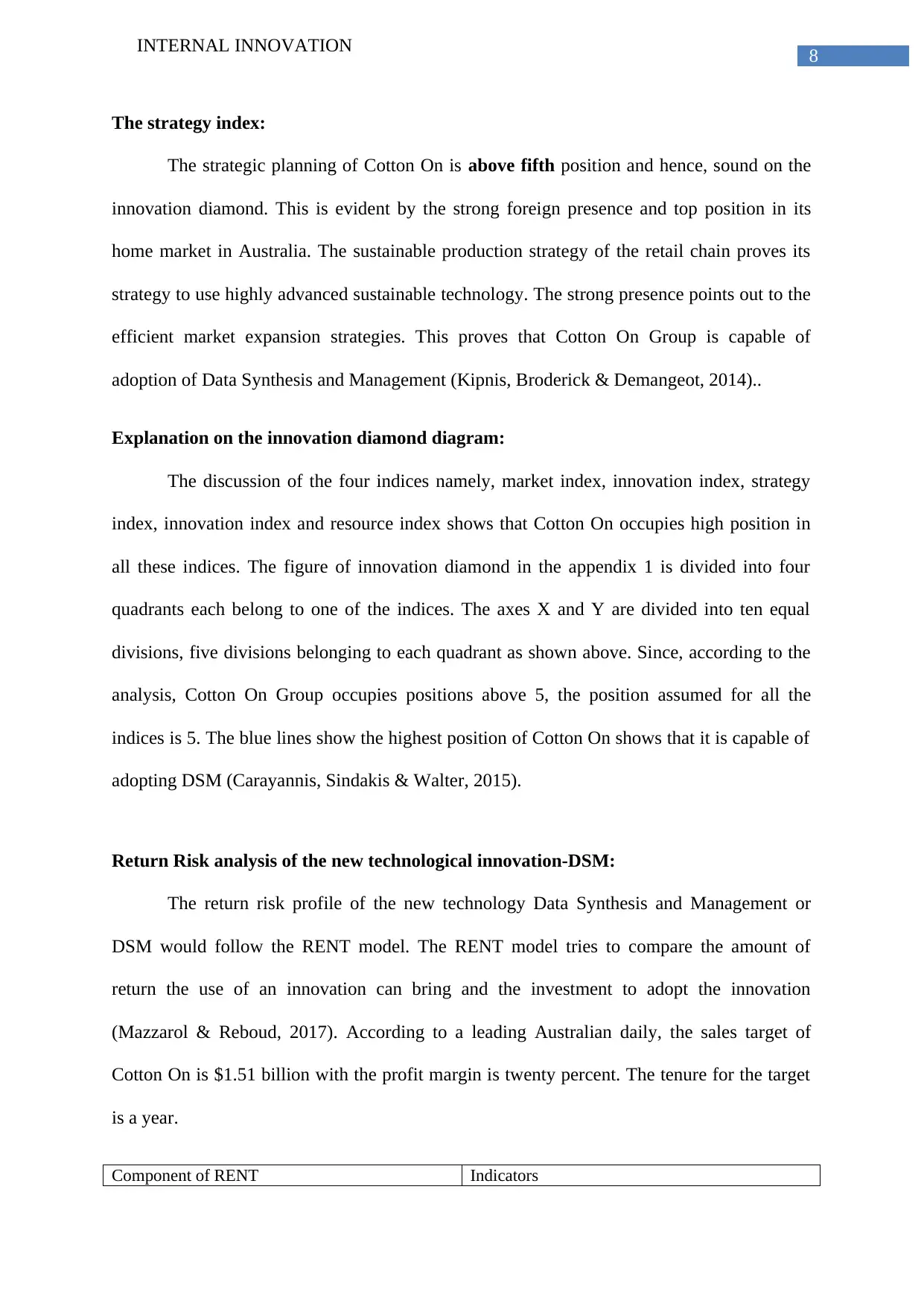
8
INTERNAL INNOVATION
The strategy index:
The strategic planning of Cotton On is above fifth position and hence, sound on the
innovation diamond. This is evident by the strong foreign presence and top position in its
home market in Australia. The sustainable production strategy of the retail chain proves its
strategy to use highly advanced sustainable technology. The strong presence points out to the
efficient market expansion strategies. This proves that Cotton On Group is capable of
adoption of Data Synthesis and Management (Kipnis, Broderick & Demangeot, 2014)..
Explanation on the innovation diamond diagram:
The discussion of the four indices namely, market index, innovation index, strategy
index, innovation index and resource index shows that Cotton On occupies high position in
all these indices. The figure of innovation diamond in the appendix 1 is divided into four
quadrants each belong to one of the indices. The axes X and Y are divided into ten equal
divisions, five divisions belonging to each quadrant as shown above. Since, according to the
analysis, Cotton On Group occupies positions above 5, the position assumed for all the
indices is 5. The blue lines show the highest position of Cotton On shows that it is capable of
adopting DSM (Carayannis, Sindakis & Walter, 2015).
Return Risk analysis of the new technological innovation-DSM:
The return risk profile of the new technology Data Synthesis and Management or
DSM would follow the RENT model. The RENT model tries to compare the amount of
return the use of an innovation can bring and the investment to adopt the innovation
(Mazzarol & Reboud, 2017). According to a leading Australian daily, the sales target of
Cotton On is $1.51 billion with the profit margin is twenty percent. The tenure for the target
is a year.
Component of RENT Indicators
INTERNAL INNOVATION
The strategy index:
The strategic planning of Cotton On is above fifth position and hence, sound on the
innovation diamond. This is evident by the strong foreign presence and top position in its
home market in Australia. The sustainable production strategy of the retail chain proves its
strategy to use highly advanced sustainable technology. The strong presence points out to the
efficient market expansion strategies. This proves that Cotton On Group is capable of
adoption of Data Synthesis and Management (Kipnis, Broderick & Demangeot, 2014)..
Explanation on the innovation diamond diagram:
The discussion of the four indices namely, market index, innovation index, strategy
index, innovation index and resource index shows that Cotton On occupies high position in
all these indices. The figure of innovation diamond in the appendix 1 is divided into four
quadrants each belong to one of the indices. The axes X and Y are divided into ten equal
divisions, five divisions belonging to each quadrant as shown above. Since, according to the
analysis, Cotton On Group occupies positions above 5, the position assumed for all the
indices is 5. The blue lines show the highest position of Cotton On shows that it is capable of
adopting DSM (Carayannis, Sindakis & Walter, 2015).
Return Risk analysis of the new technological innovation-DSM:
The return risk profile of the new technology Data Synthesis and Management or
DSM would follow the RENT model. The RENT model tries to compare the amount of
return the use of an innovation can bring and the investment to adopt the innovation
(Mazzarol & Reboud, 2017). According to a leading Australian daily, the sales target of
Cotton On is $1.51 billion with the profit margin is twenty percent. The tenure for the target
is a year.
Component of RENT Indicators
⊘ This is a preview!⊘
Do you want full access?
Subscribe today to unlock all pages.

Trusted by 1+ million students worldwide
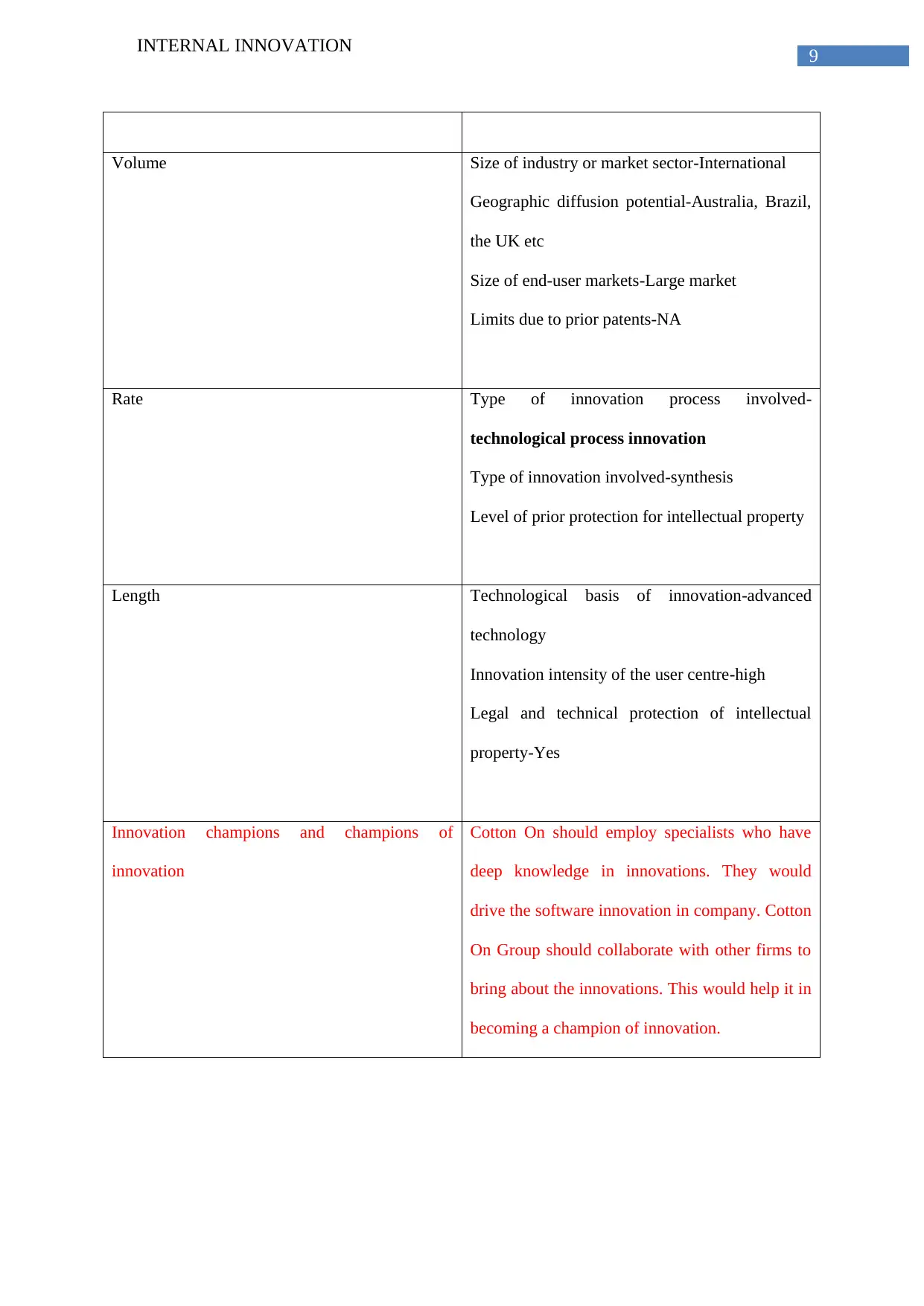
9
INTERNAL INNOVATION
Volume Size of industry or market sector-International
Geographic diffusion potential-Australia, Brazil,
the UK etc
Size of end-user markets-Large market
Limits due to prior patents-NA
Rate Type of innovation process involved-
technological process innovation
Type of innovation involved-synthesis
Level of prior protection for intellectual property
Length Technological basis of innovation-advanced
technology
Innovation intensity of the user centre-high
Legal and technical protection of intellectual
property-Yes
Innovation champions and champions of
innovation
Cotton On should employ specialists who have
deep knowledge in innovations. They would
drive the software innovation in company. Cotton
On Group should collaborate with other firms to
bring about the innovations. This would help it in
becoming a champion of innovation.
INTERNAL INNOVATION
Volume Size of industry or market sector-International
Geographic diffusion potential-Australia, Brazil,
the UK etc
Size of end-user markets-Large market
Limits due to prior patents-NA
Rate Type of innovation process involved-
technological process innovation
Type of innovation involved-synthesis
Level of prior protection for intellectual property
Length Technological basis of innovation-advanced
technology
Innovation intensity of the user centre-high
Legal and technical protection of intellectual
property-Yes
Innovation champions and champions of
innovation
Cotton On should employ specialists who have
deep knowledge in innovations. They would
drive the software innovation in company. Cotton
On Group should collaborate with other firms to
bring about the innovations. This would help it in
becoming a champion of innovation.
Paraphrase This Document
Need a fresh take? Get an instant paraphrase of this document with our AI Paraphraser
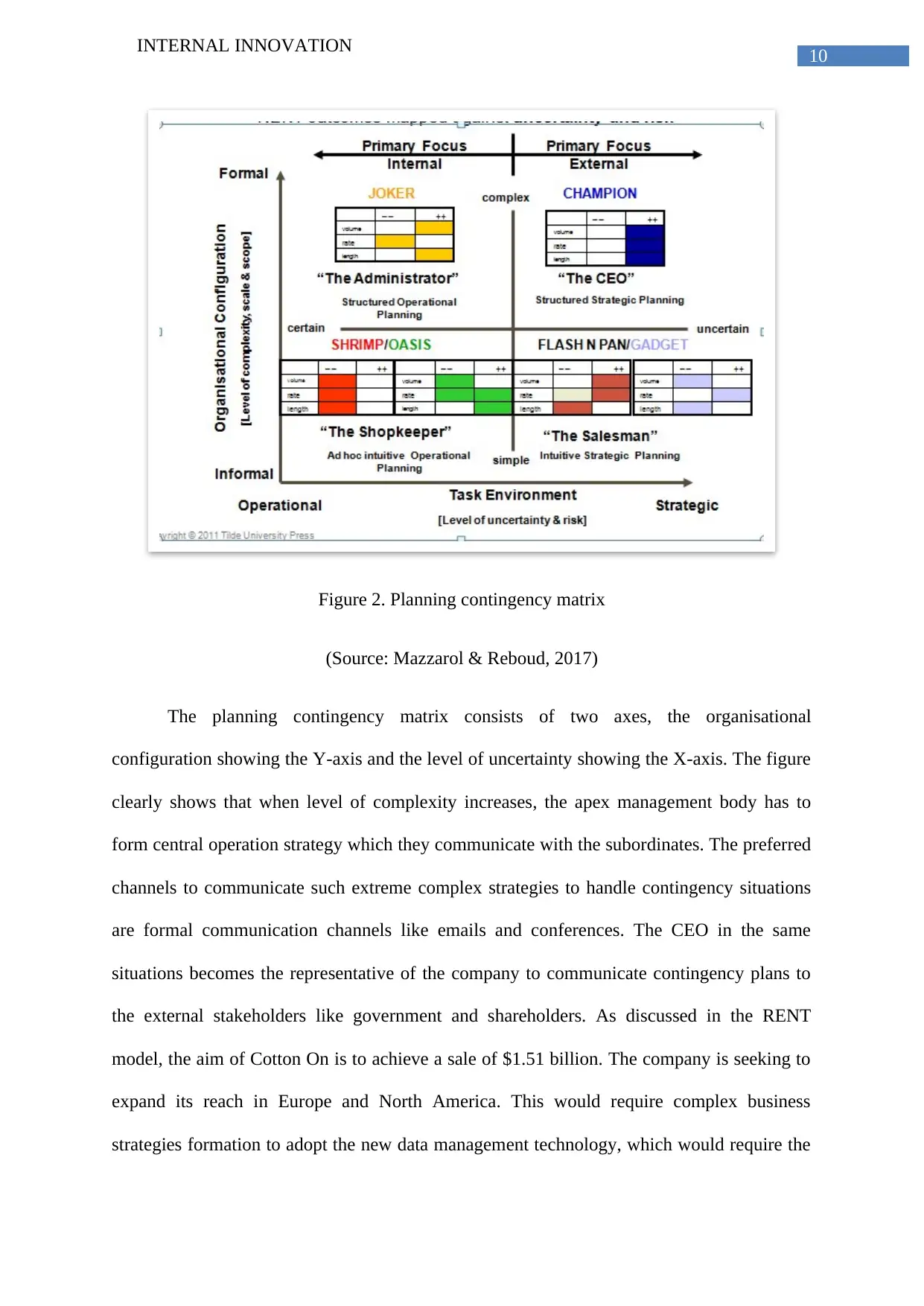
10
INTERNAL INNOVATION
Figure 2. Planning contingency matrix
(Source: Mazzarol & Reboud, 2017)
The planning contingency matrix consists of two axes, the organisational
configuration showing the Y-axis and the level of uncertainty showing the X-axis. The figure
clearly shows that when level of complexity increases, the apex management body has to
form central operation strategy which they communicate with the subordinates. The preferred
channels to communicate such extreme complex strategies to handle contingency situations
are formal communication channels like emails and conferences. The CEO in the same
situations becomes the representative of the company to communicate contingency plans to
the external stakeholders like government and shareholders. As discussed in the RENT
model, the aim of Cotton On is to achieve a sale of $1.51 billion. The company is seeking to
expand its reach in Europe and North America. This would require complex business
strategies formation to adopt the new data management technology, which would require the
INTERNAL INNOVATION
Figure 2. Planning contingency matrix
(Source: Mazzarol & Reboud, 2017)
The planning contingency matrix consists of two axes, the organisational
configuration showing the Y-axis and the level of uncertainty showing the X-axis. The figure
clearly shows that when level of complexity increases, the apex management body has to
form central operation strategy which they communicate with the subordinates. The preferred
channels to communicate such extreme complex strategies to handle contingency situations
are formal communication channels like emails and conferences. The CEO in the same
situations becomes the representative of the company to communicate contingency plans to
the external stakeholders like government and shareholders. As discussed in the RENT
model, the aim of Cotton On is to achieve a sale of $1.51 billion. The company is seeking to
expand its reach in Europe and North America. This would require complex business
strategies formation to adopt the new data management technology, which would require the
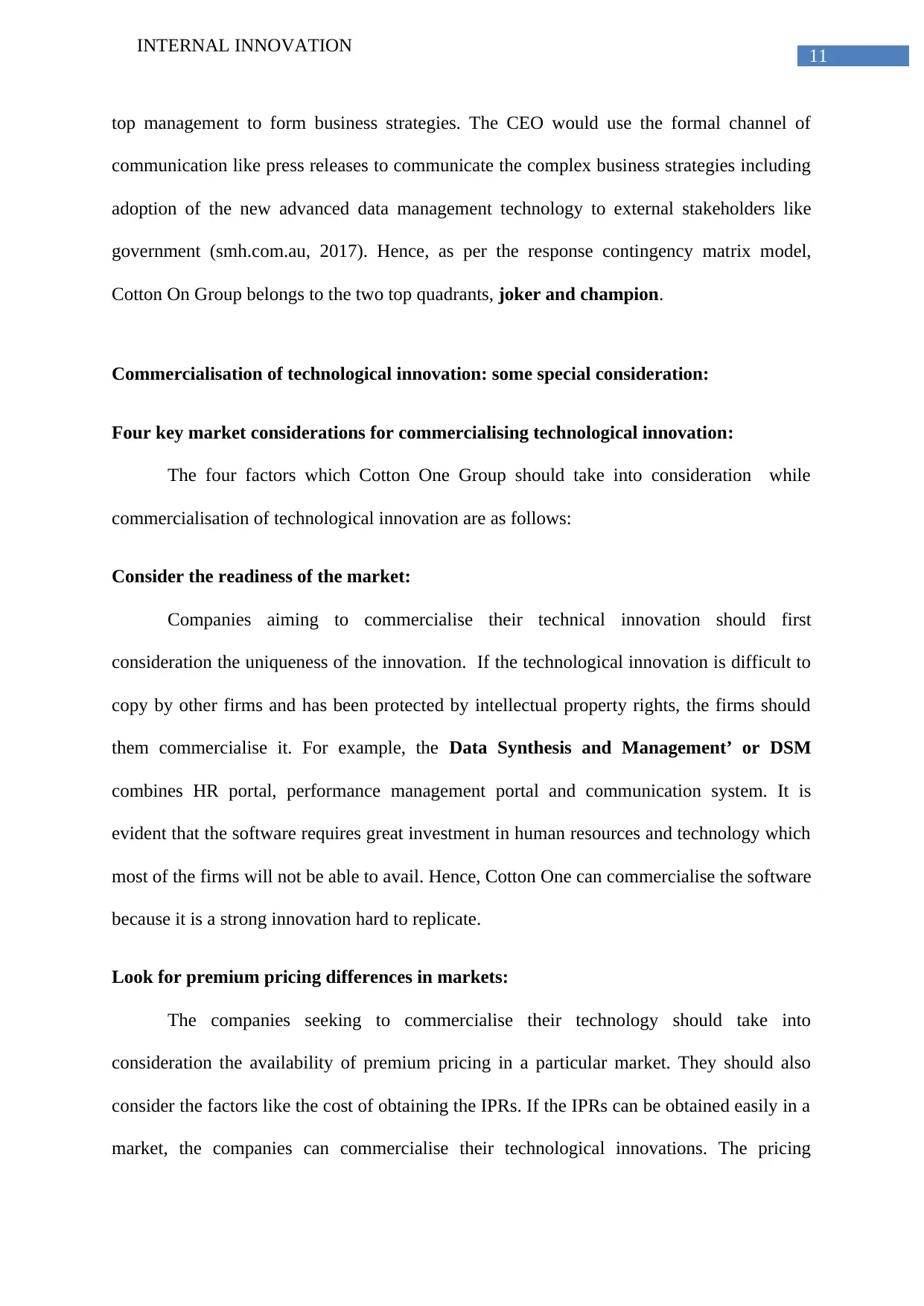
11
INTERNAL INNOVATION
top management to form business strategies. The CEO would use the formal channel of
communication like press releases to communicate the complex business strategies including
adoption of the new advanced data management technology to external stakeholders like
government (smh.com.au, 2017). Hence, as per the response contingency matrix model,
Cotton On Group belongs to the two top quadrants, joker and champion.
Commercialisation of technological innovation: some special consideration:
Four key market considerations for commercialising technological innovation:
The four factors which Cotton One Group should take into consideration while
commercialisation of technological innovation are as follows:
Consider the readiness of the market:
Companies aiming to commercialise their technical innovation should first
consideration the uniqueness of the innovation. If the technological innovation is difficult to
copy by other firms and has been protected by intellectual property rights, the firms should
them commercialise it. For example, the Data Synthesis and Management’ or DSM
combines HR portal, performance management portal and communication system. It is
evident that the software requires great investment in human resources and technology which
most of the firms will not be able to avail. Hence, Cotton One can commercialise the software
because it is a strong innovation hard to replicate.
Look for premium pricing differences in markets:
The companies seeking to commercialise their technology should take into
consideration the availability of premium pricing in a particular market. They should also
consider the factors like the cost of obtaining the IPRs. If the IPRs can be obtained easily in a
market, the companies can commercialise their technological innovations. The pricing
INTERNAL INNOVATION
top management to form business strategies. The CEO would use the formal channel of
communication like press releases to communicate the complex business strategies including
adoption of the new advanced data management technology to external stakeholders like
government (smh.com.au, 2017). Hence, as per the response contingency matrix model,
Cotton On Group belongs to the two top quadrants, joker and champion.
Commercialisation of technological innovation: some special consideration:
Four key market considerations for commercialising technological innovation:
The four factors which Cotton One Group should take into consideration while
commercialisation of technological innovation are as follows:
Consider the readiness of the market:
Companies aiming to commercialise their technical innovation should first
consideration the uniqueness of the innovation. If the technological innovation is difficult to
copy by other firms and has been protected by intellectual property rights, the firms should
them commercialise it. For example, the Data Synthesis and Management’ or DSM
combines HR portal, performance management portal and communication system. It is
evident that the software requires great investment in human resources and technology which
most of the firms will not be able to avail. Hence, Cotton One can commercialise the software
because it is a strong innovation hard to replicate.
Look for premium pricing differences in markets:
The companies seeking to commercialise their technology should take into
consideration the availability of premium pricing in a particular market. They should also
consider the factors like the cost of obtaining the IPRs. If the IPRs can be obtained easily in a
market, the companies can commercialise their technological innovations. The pricing
⊘ This is a preview!⊘
Do you want full access?
Subscribe today to unlock all pages.

Trusted by 1+ million students worldwide
1 out of 19
Related Documents
Your All-in-One AI-Powered Toolkit for Academic Success.
+13062052269
info@desklib.com
Available 24*7 on WhatsApp / Email
![[object Object]](/_next/static/media/star-bottom.7253800d.svg)
Unlock your academic potential
Copyright © 2020–2025 A2Z Services. All Rights Reserved. Developed and managed by ZUCOL.





